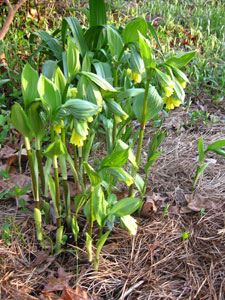Resource Library
Plant of the Week: Korean Fairy Bell
The University of Arkansas System Division of Agriculture does not promote, support or recommend plants featured in "Plant of the Week." Please consult your local Extension office for plants suitable for your region.
Plant of the Week
Korean Fairy Bell
Latin: Disporum uniflorum

The arrival of spring is a gift to gardeners because each day provides opportunity for new discoveries. In early April of each year, I’m always delighted when my Korean Fairy Bell explodes from the ground in my shade garden and presents its bright yellow flowers, still shaking off the soil from which it emerged.
Twenty species of Disporum have been described in East Asia, with Disporum uniflorum (also often listed under its old name, D. flavens) native to Korea and adjacent areas of northeastern China. It is a clump-forming herbaceous perennial, spreading by rhizomes that will in 10 years time form a clump up to 2 feet across. Unlike its weedy cousin, D. sessile ‘Variegatum,’ which spreads like Johnson grass, Korean fairy bell is decidedly well behaved in the garden.
The Flora of China lists the Disporums as belonging to the Lily family, but most botanists have moved them into either a family with Colchicum or lily of the valley. Of our eastern American flora, this species most closely resembles the yellow-flowered bellwort (Uvularia grandiflora), which also grows in a moist, woodland habitat. In the Pacific Northwest, five species of woodland plants once classified as belonging to the Disporum genus are now separated into their own genus: Prosartes.
The Korean fairy bell emerges in early spring, with pencil-sized stems sheathed in 2 to 4 basal, sessile leaves that partially encircle the stem. Plants grow 2 to 3 feet tall, depending on the moisture level and fertility of the site. The uppermost 2 or 3 leaves produce leafy branches, which in turn may produce one or two more branches. The elliptical leaves are glossy green, 3 inches long and 2 inches wide and marked with prominent parallel veins.
At the end of each branch is produced two or three 2 inch long, 6-tepaled bright yellow flowers that nod downward. The emergence of the plants and the opening of the flowers occur almost simultaneously. The flowers are followed in midsummer with a series of peanut-sized black berries. I have grown the plant for 10 years and have seen no plants emerge from seed.
This and several other Disporum species was introduced to the gardening world thanks to the efforts of Seattle area nurseryman and plant explorer Dan Hinkley. During the 1990s, Hinkley traveled extensively in China, Japan, Korea and Taiwan, where he scoured the countryside, gardens and nurseries for new and interesting plants he could bring back to his nursery, called Heronswood. Woodland plants were a specialty of his firm, and during the too-short run of his ownership, he became perhaps the most highly regarded purveyor of new plants during the latter half of the 20th century.
I have found Korean fairy bells easy to grow and trouble-free in my woodland garden. It should have partial to full shade to avoid leaf scorch. It is hardy from zones 5 through 8 and grows well in any average, well-drained woodland soil. It has not been bothered by any pests in the decade I have grown it. Propagation is easy by division, either in the early spring before new growth starts or by digging a clump of roots in midsummer.
By: Gerald Klingaman, retired
Retired Extension Horticulturist - Ornamentals
Extension News - May 6, 2011
The University of Arkansas System Division of Agriculture does not maintain lists of retail outlets where these plants can be purchased. Please check your local nursery or other retail outlets to ask about the availability of these plants for your growing area.